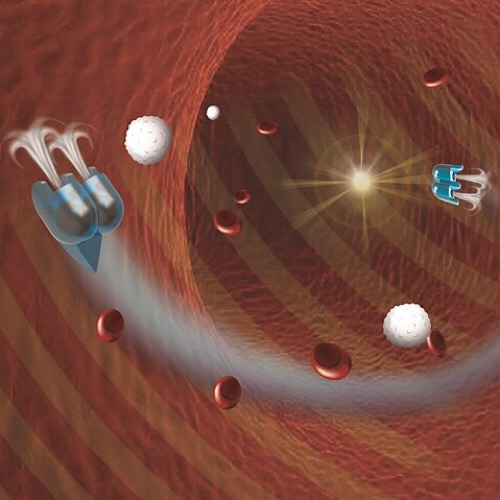Engineers at Cornell University have developed cell-sized microrobots that can be powered and steered by ultrasonic waves through the human body. The robots could one day be used as a tool for targeted drug delivery.
Professor Mingming Wu and her lab have, for more than a decade, investigated how microorganisms – from bacteria to cancer cells – migrate and communicate with their environment. The researchers aim to create a remotely controlled microrobot that can navigate in the human body. Initially, they tried designing a 3D-printed microrobot that mimicked how bacteria use their hair-like flagellum to propel themselves; these early robots were cumbersome and the effort collapsed.
Wu and her colleagues took an alternative, less literal approach to microrobot design. The primary hurdle was how to power the device to swim through the human body.
“Bacteria and sperm basically consume organic material in the surrounding fluid and that is sufficient to power them,” Wu explained. “But for engineered robots it’s tough because if they carry a battery, it’s too heavy for them to move.”
The researchers tried using high-frequency sound waves. Because ultrasound is beyond the normal human hearing range, it can be easily used in a lab setting without discomfort. The technology has already been deemed safe for clinical studies by the FDA.
Dr Tao Luo, a former researcher in Wu’s lab, worked with the Cornell NanoScale Science and Technology Facility to create a triangular microrobotic swimmer made from resin which resembled “an insect crossed with a rocket”. The robot has a pair of cavities etched in its back; as the resin is hydrophobic, submerging the robot in a solution causes a tiny air bubble to be trapped in each cavity. When an ultrasound transducer is aimed at the robot, the air bubble oscillates, generating vortices and propelling the swimmer forward.
Although other engineers have built swimmers which use single bubbles for propulsion, the Cornell engineers are the first to pioneer a version that uses two bubbles: each with a different diameter opening in their respective cavity. They can excite either bubble by varying resonant frequency, or alternatively tune them together, allowing them control over direction of propulsion.
The next challenge for Luo and the other engineers will be making the swimmers biocompatible, such that they can navigate among blood cells roughly the size that they are. They will also need to be made from biodegradable material so many may be released at once; in the same manner that many sperm are released in each ejaculation while only one is required for fertilisation, volume is key for success.
“For drug delivery, you could have a group of microrobotic swimmers, and if one failed during the journey, that’s not a problem. That’s how nature survives,” said Wu. “In a way, it’s a more robust system. Smaller does not mean weaker.
“A group of them is undefeatable. I feel like these nature-inspired tools typically are more sustainable, because nature has proved it works.”
Source; E&T










